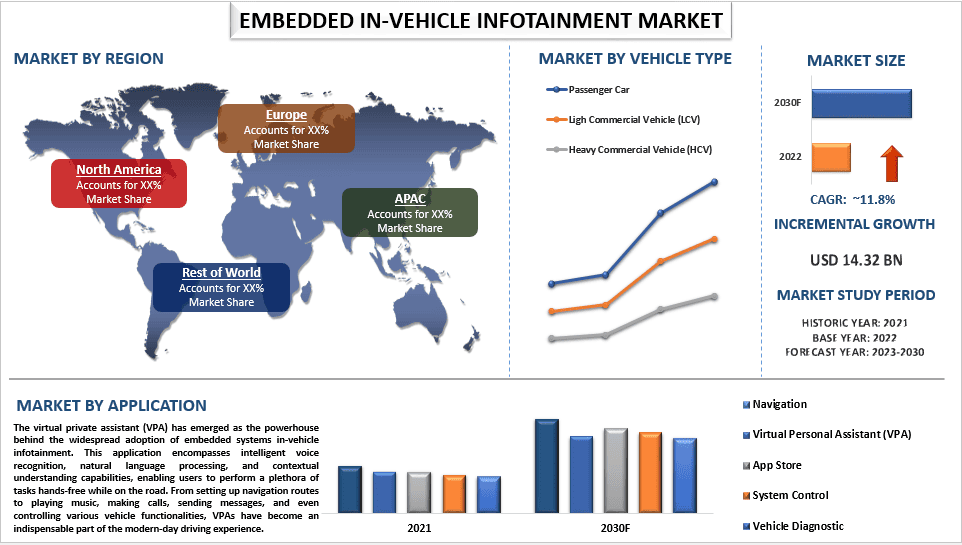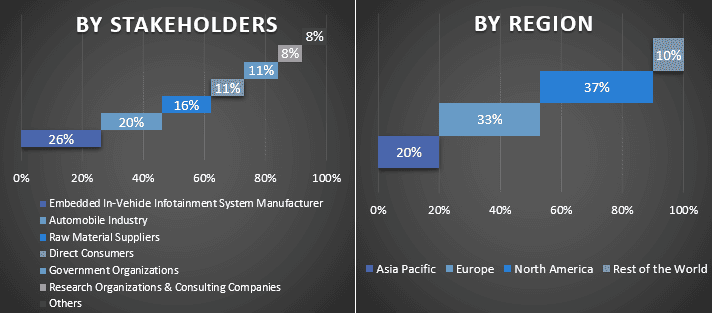- Home
- About Us
- Industry
- Services
- Reading
- Contact Us
Embedded In-Vehicle Infotainment Market: Current Analysis and Forecast (2023-2030)
Emphasis on Vehicle Type (Passenger Car, Light Commercial Vehicle (LCV), and Heavy Commercial Vehicle (HCV)); Component (infotainment Units, Passenger Displays, Instrument Cluster Displays, and Head-Up Displays); Connectivity (3G/4G and 5G); Application (Navigation, Virtual Private Assistant (VPA), App Store, System Control, and Vehicle Diagnostics); and Region/Country

The Embedded In-Vehicle Infotainment Market was valued at 14.32 billion in the year 2022 and is expected to grow at a strong rate of around 11.8% during the forecast period (2023-2030), owing to the rising demand for connected car features and the growing demand for the passenger vehicles. Furthermore, the proliferation of smart and connected cars is reshaping the automotive landscape, as consumers seek enhanced connectivity and convenience features in their vehicles. The increasing penetration and speed of the internet, coupled with advancements in IoT technology, are fueling the demand for intelligent infotainment systems. Moreover, the global shift towards sustainable mobility and the increasing adoption of electric vehicles have further catalyzed the growth of in-vehicle infotainment systems. With EVs becoming increasingly popular, there is a rising need for advanced infotainment solutions tailored to the unique requirements of electric vehicles. Additionally, the growing urbanization and increasing disposable income levels of the population are also contributing to the expansion of the in-vehicle infotainment market. Urban dwellers, who spend a significant amount of time in traffic, are seeking entertainment and productivity features in their vehicles. Moreover, rising affluence levels have made premium infotainment systems more accessible to a broader consumer base.
Some of the major players operating in the market include HARMAN International; Panasonic Holdings Corporation; ALPS ALPINE CO., LTD; Robert Bosch GmbH; Continental AG; Clarion; Phinia Inc.; DENSO CORPORATION.; JVCKENWOOD Corporation; and Visteon Corporation Several M&As along with partnerships have been undertaken by these players to facilitate customers with hi-tech and innovative products/technologies
Insights Presented in the Report
“Amongst vehicle types, the passenger car segment held the significant market share in terms of value in 2022.”
Based on vehicle type, the market is categorized into passenger cars, light commercial vehicles (LCV), and heavy commercial vehicles (HCV). Passenger cars generate the maximum demand for embedded in-vehicle infotainment systems. The primary factor responsible for this includes the need to enhance the consumer experience in the cockpit. As consumers spend more time in their cars for daily commuting and travel, they seek entertainment and connectivity options. Embedded infotainment systems provide access to music, navigation, communication, and other features, enhancing the overall driving experience. Furthermore, passenger cars are increasingly incorporating advanced technologies to improve safety, convenience, and entertainment. Embedded infotainment systems are a key feature that adds value to the vehicle and their presence has become a deal breaker for consumers during the buying process. Factors like these are playing a pivotal role in driving the demand for embedded in-vehicle infotainment systems even in low-end passenger cars, which was once the luxury that only high-end car users had access to.
“Amongst applications, the Virtual Private Assistant (VPA) held a significant market share in 2022.”
Based on application, the market is segmented into navigation, virtual private assistant (VPA), app store, system control, and vehicle diagnostics. The virtual private assistant (VPA) has emerged as the powerhouse behind the widespread adoption of embedded systems in-vehicle infotainment. This application encompasses intelligent voice recognition, natural language processing, and contextual understanding capabilities, enabling users to perform a plethora of tasks hands-free while on the road. From setting up navigation routes to playing music, making calls, sending messages, and even controlling various vehicle functionalities, VPAs have become an indispensable part of the modern-day driving experience. Furthermore, VPAs leverage artificial intelligence and machine learning algorithms to continuously improve their performance and capabilities. This ensures that users have access to the latest features and functionalities, keeping their driving experience fresh and engaging, and hence are one of the most sought-after applications of the embedded-in-vehicle infotainment systems.
“Asia Pacific is expected to experience a substantial growth in the predicted timeframe of (2023-2030).”
The Asia Pacific region has swiftly emerged as one of the fastest-growing embedded in-vehicle infotainment markets globally, showcasing exponential growth driven by a multitude of factors. One of the key factors responsible for the rapid growth of the automotive market in the Asia Pacific region is the substantial increase in economic activity across various countries. According to recent data from the Asian Development Bank, countries in the Asia Pacific region have been experiencing robust economic growth, leading to a rise in consumer purchasing power and an increased inclination towards vehicle ownership. This economic prosperity has significantly boosted the demand for automobiles, fostering a conducive environment for market expansion. Moreover, the escalation in public and private investments in infrastructure development and transportation systems has also played a pivotal role in propelling the automotive market in the Asia Pacific region. Governments across the region are heavily investing in building and upgrading transportation networks, including roads, bridges, and highways, to accommodate the growing urban population and facilitate smoother mobility. Additionally, private sector investments in automotive manufacturing facilities and technological advancements have further catalyzed the sector’s growth trajectory. Furthermore, the phenomenon of growing urbanization in the Asia Pacific region has been another crucial driver boosting the automotive market. As cities expand and populations concentrate in urban areas, the need for personal transportation has escalated, leading to a surge in vehicle sales. Moreover, the rise in disposable income levels across various demographics in the Asia Pacific region has been a significant contributor to the burgeoning automotive market. With more consumers experiencing a higher standard of living and increased purchasing power, the desire to own personal vehicles has intensified, leading to a surge in automotive sales. Notably, the growing demand for automobiles in the Asia Pacific region has also catalyzed the market for embedded in-vehicle infotainment systems. As consumers seek enhanced connectivity, entertainment, and convenience features in their vehicles, the demand for sophisticated infotainment systems has also surged.
Embedded In-Vehicle Infotainment Market Report Coverage

Reasons to buy this report:
- The study includes market sizing and forecasting analysis validated by authenticated key industry experts.
- The report presents a quick review of overall industry performance at one glance.
- The report covers an in-depth analysis of prominent industry peers with a primary focus on key business financials, product portfolios, expansion strategies, and recent developments.
- Detailed examination of drivers, restraints, key trends, and opportunities prevailing in the industry.
- The study comprehensively covers the market across different segments.
- Deep dive regional level analysis of the industry.
Customization Options:
The global Embedded In-Vehicle Infotainment market can further be customized as per the requirement or any other market segment. Besides this, UMI understands that you may have your own business needs, hence feel free to contact us to get a report that completely suits your requirements.
Table of Content
Research Methodology for the Embedded In-Vehicle Infotainment Market Analysis (2023-2030)
Analyzing the historical market, estimating the current market, and forecasting the future market of the global Embedded In-Vehicle Infotainment market were the three major steps undertaken to create and analyze the adoption of Embedded In-Vehicle Infotainments in major regions globally. Exhaustive secondary research was conducted to collect the historical market numbers and estimate the current market size. Secondly, to validate these insights, numerous findings and assumptions were taken into consideration. Moreover, exhaustive primary interviews were also conducted, with industry experts across the value chain of the global Embedded In-Vehicle Infotainment market. Post assumption and validation of market numbers through primary interviews, we employed a top-down/bottom-up approach to forecasting the complete market size. Thereafter, market breakdown and data triangulation methods were adopted to estimate and analyze the market size of segments and sub-segments of the industry pertains to. Detailed methodology is explained below:
Analysis of Historical Market Size
Step 1: In-Depth Study of Secondary Sources:
A detailed secondary study was conducted to obtain the historical market size of the Embedded In-Vehicle Infotainment market through company internal sources such as annual reports & financial statements, performance presentations, press releases, etc., and external sources including journals, news & articles, government publications, competitor publications, sector reports, third-party database, and other credible publications.
Step 2: Market Segmentation:
After obtaining the historical market size of the Embedded In-Vehicle Infotainment market, we conducted a detailed secondary analysis to gather historical market insights and share for different segments & sub-segments for major regions. Major segments are included in the report as vehicle type, component, connectivity, and application. Further country-level analyses were conducted to evaluate the overall adoption of testing models in that region.
Step 3: Factor Analysis:
After acquiring the historical market size of different segments and sub-segments, we conducted a detailed factor analysis to estimate the current market size of the Embedded In-Vehicle Infotainment market. Further, we conducted factor analysis using dependent and independent variables such as vehicle type, component, connectivity, and application of the Embedded In-Vehicle Infotainment market. A thorough analysis was conducted of demand and supply-side scenarios considering top partnerships, mergers and acquisitions, business expansion, and product launches in the Embedded In-Vehicle Infotainment market sector across the globe.
Current Market Size Estimate & Forecast
Current Market Sizing: Based on actionable insights from the above 3 steps, we arrived at the current market size, key players in the global Embedded In-Vehicle Infotainment market, and market shares of the segments. All the required percentage shares split, and market breakdowns were determined using the above-mentioned secondary approach and were verified through primary interviews.
Estimation & Forecasting: For market estimation and forecast, weights were assigned to different factors including drivers & trends, restraints, and opportunities available for the stakeholders. After analyzing these factors, relevant forecasting techniques i.e., the top-down/bottom-up approach were applied to arrive at the market forecast for 2030 for different segments and sub-segments across the major markets globally. The research methodology adopted to estimate the market size encompasses:
- The industry’s market size, in terms of revenue (USD) and the adoption rate of the Embedded In-Vehicle Infotainment market across the major markets domestically
- All percentage shares, splits, and breakdowns of market segments and sub-segments
- Key players in the global Embedded In-Vehicle Infotainment market in terms of products offered. Also, the growth strategies adopted by these players to compete in the fast-growing market.
Market Size and Share Validation
Primary Research: In-depth interviews were conducted with the Key Opinion Leaders (KOLs) including Top Level Executives (CXO/VPs, Sales Head, Marketing Head, Operational Head, Regional Head, Country Head, etc.) across major regions. Primary research findings were then summarized, and statistical analysis was performed to prove the stated hypothesis. Inputs from primary research were consolidated with secondary findings, hence turning information into actionable insights.
Split of Primary Participants in Different Regions

Market Engineering
The data triangulation technique was employed to complete the overall market estimation and to arrive at precise statistical numbers for each segment and sub-segment of the global Embedded In-Vehicle Infotainment market. data was split into several segments & sub-segments post studying various parameters and trends in the areas of purity and application in the global Embedded In-Vehicle Infotainment market.
The main objective of the Global Embedded In-Vehicle Infotainment Market Study
The current & future market trends of the global Embedded In-Vehicle Infotainment market were pinpointed in the study. Investors can gain strategic insights to base their discretion for investments on the qualitative and quantitative analysis performed in the study. Current and future market trends determined the overall attractiveness of the market at a regional level, providing a platform for the industrial participant to exploit the untapped market to benefit from a first-mover advantage. Other quantitative goals of the studies include:
- Analyze the current and forecast market size of the Embedded In-Vehicle Infotainment market in terms of value (USD). Also, analyze the current and forecast market size of different segments and sub-segments.
- Segments in the study include areas of vehicle type, component, connectivity, and application.
- Define and analyze the regulatory framework for the Embedded In-Vehicle Infotainment
- Analyze the value chain involved with the presence of various intermediaries, along with analyzing customer and competitor behaviors of the industry
- Analyze the current and forecast market size of the Embedded In-Vehicle Infotainment market for the major region
- Major countries of regions studied in the report include Asia Pacific, Europe, North America, and the Rest of the World
- Company profiles of the Embedded In-Vehicle Infotainment market and the growth strategies adopted by the market players to sustain in the fast-growing market
- Deep dive regional level analysis of the industry
Frequently Asked Questions FAQs
Q1: What is the current market size and growth potential of the global Embedded In-Vehicle Infotainment market?
Q2: What are the driving factors for the growth of the global Embedded In-Vehicle Infotainment Market?
Q3: Which segment has the largest share of the global Embedded In-Vehicle Infotainment market by Vehicle Type?
Q4: What are the emerging technologies and trends in the global Embedded In-Vehicle Infotainment market?
Q5: Which region will be the fastest growing global Embedded In-Vehicle Infotainment market?
Q6: Who are the key players in the global Embedded In-Vehicle Infotainment market?
Related Reports
Customers who bought this item also bought










